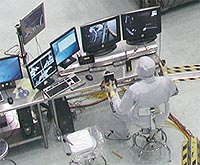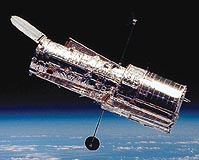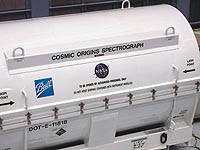|
Technology
not only expands humankinds capabilities on Earth, it is
helping scientists push the limits of knowledge about the
universe. But even the most advanced technology needs the
skilled minds and hands of human beings behind it. IBEW
members do just such work in missions that have opened
doors to the universe and in
 monitoring
every deep space mission undertaken by the National Aeronautical
and Space Administration (NASA). This two-part series explores
the work done by these highly skilled brothers and sisters
and recounts some of the down-to-earth job struggles they
face. monitoring
every deep space mission undertaken by the National Aeronautical
and Space Administration (NASA). This two-part series explores
the work done by these highly skilled brothers and sisters
and recounts some of the down-to-earth job struggles they
face.
Part ILocal 1501 and the
Hubble Telescope
The concept of a whole being
greater than its parts is nowhere represented more powerfully
than by the Hubble Space Telescope and its radiant images
of other galaxies.
Since its launch in 1990, the
Hubble has provided astronomers, students and the world community
with unprecedented discoveries such as the birth of stars,
and the accelerated growth of the universe.
Hubbles parts, including its
batteries and gyroscopes, are wearing out. Without repairs,
they will not sustain the telescope beyond 2008.
After a contentious debate over
Hubbles futurea debate that involved the BrotherhoodNASA
announced on August 9 that a robotic mission would be launched
to install new parts and scientific equipment that will enhance
its research capabilities.
NASAs announcement reminds us
that Hubbles magnificence is only possible because of its
parts. These parts deliver their wonders through the work
of members of the IBEW who work for Mantech Inc. at NASAs
Goddard Space Center in Maryland, and who helped the Hubble
overcome early difficulties to become one of the most productive
missions in NASA history.
 Mike
Kurtz, unit chairman and vice president of IBEW Local
1501, based in Cockeysville, Maryland, a Mantech group
leader, describes the work of the locals 200 engineers, technicians,
draftsmen and sanitation technicians as "support."
The Hubble has provided steady employment to between 50 and
70 Local
1501 members and also members who perform facilities maintenance,
represented by IBEW Local 26 in Washington, D.C., hundreds
more at Goddard and over 400 scientists and technicians at
Johns Hopkins University in nearby Baltimore. Mike
Kurtz, unit chairman and vice president of IBEW Local
1501, based in Cockeysville, Maryland, a Mantech group
leader, describes the work of the locals 200 engineers, technicians,
draftsmen and sanitation technicians as "support."
The Hubble has provided steady employment to between 50 and
70 Local
1501 members and also members who perform facilities maintenance,
represented by IBEW Local 26 in Washington, D.C., hundreds
more at Goddard and over 400 scientists and technicians at
Johns Hopkins University in nearby Baltimore.
Crews Go the Extra Mile
After leaving an "air shower,"
that vacuums dust from his street clothes, Kelly Scharmann,
an engineering technician and Local 1501 member, slips into
white coveralls, boots and gloves. He pulls a hood over his
head and a mask over his mouth and nose. Scharmann will spend
the next 12 hours in Goddards vast "clean room,"
where airborne matter is reduced to micron-sized particles
to protect sensitive electronic devices. The one million cubic
foot room, where astronauts have trained for Hubble repair
missions, contains equipment massive enough to require lifting
by two 35-ton overhead cranes. A splash of metallic orange
insulating foil that protects equipment from extreme space
temperatures shrouds several of the hulking structures, some
of which accompanied prior Hubble repair missions. The foil
is space-age upholstery, custom-cut by IBEW members.
Scharmann, a 15-year veteran
of Mantech, has been working on one of the robots that could
be commanded to repair the Hubble. "The robot would fall
under its own weight," says Scharmann, "without
the support structure that we designed to simulate a weightless
environment."
"They worked flat out,
12-hour days, seven days a week," says Giles Robinson,
of Canadas MD Robotics, who credits IBEW members with "remarkable
progress in a short time," to meet the August review
of the robotic repair option. Its not the first time that
Scharmann, his co-worker, senior technician Rick Wilson, and
others have gone the extra mile.
Some were trained to simulate
weightless equipment repairs in underwater tanks, training
astronauts in facilities in Alabama and Texas. Others accompanied
freshly retrofitted satellite parts on 3-day barge trips from
the Chesapeake Bay to Cape Kennedy in Florida. Some are in
France for two months working on a new satellite.
Dion Guthrie, business manager
and president of Local
1501, champions the unique attributes of the Goddard work
force. "Job responsibilities change almost daily,"
he says. "The workers thirst for training. This is the
only workplace that I have experienced where workers insistedin
contract negotiationsthat the company evaluates them on a
yearly basis. If the evaluation is not performed within 30
days of a members anniversary date, the worker does a self-evaluation,
and it goes into his or her personnel record."
"The Hubble is just one
part of the work of our members at Goddard," explains
Kurtz. One building houses a noise simulator that tests parts
for vibration resistance. Even with the bank vault-thick doors
shut, he says, "the noise will blow you out of the building."
Across from the noise simulator
is the thermal vacuum chamber that tests satellites for their
ability to withstand the severity of low vacuum and temperature
extremes. Entire satellites are lowered by crane into the
colossal cauldron, like ice cubes into a glass, and left to
cook or freeze for days. A centrifuge, resembling a giant
kitchen blender, spins satellites at speeds that simulate
the gravitational force that will be encountered on the mission.
Prior to one satellite launch,
Kurtz recalls, astronauts encountered an unexpected problem
with the operation of certain equipment. "The mission
was delayed for four days. Our crews were on call the entire
time," he says, "repeatedly working with replicas
at Goddard to help solve the problem."
Laura McKelvey, a mechanical
integration engineer, works on the Wide Field Camera 3, that
will provide high-resolution coverage from the near-infrared
domain of the spectrum to the ultraviolet. IBEW members built
the camera. "I love the job," says McKelvey, who
started with Mantech in November 2003 after graduating from
Penn State University-Erie with a B.A. in engineering.
 Niko
Stergiou works on the Wide Field Camera and shares McKelveys
enthusiasm. Stergiou, a optics engineering technician, says,
"This is a good working environment. I think that you
will find a consensus that nobody is worried about anyone
else getting the spotlight because we are one entity."
Nearby is the Cosmic Origins Spectrograph (see above right),
also supported by IBEW members, which will accompany the Wide
Field Camera on the robotic mission. Niko
Stergiou works on the Wide Field Camera and shares McKelveys
enthusiasm. Stergiou, a optics engineering technician, says,
"This is a good working environment. I think that you
will find a consensus that nobody is worried about anyone
else getting the spotlight because we are one entity."
Nearby is the Cosmic Origins Spectrograph (see above right),
also supported by IBEW members, which will accompany the Wide
Field Camera on the robotic mission.
More>>
|

